Falmouth, Cornwall
Up to 1834
A parliamentary report of 1777 recorded parish workhouses in operation at Budock (with accommodation for up to 15 inmates), and at Penryn (up to 50 inmates).
Penryn had a workhouse on Church Lane from 1821 onwards. Edward and Mary Tregaskis were governor and governess from 1821 onwards.
Mylor had a workhouse on Lemon Hill at Mylor Bridge dating from 1827. The building was converted to a National School in around 1850.
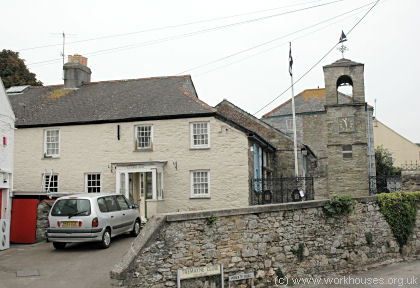
Mylor former workhouse, 2005.
© Peter Higginbotham.
Falmouth town's workhouse stood at the east side of Gyllyng Street.
After 1834
Falmouth Poor Law Union was formed on 13th June 1837. Its operation was overseen by an elected Board of Guardians, 23 in number, representing its 10 constituent parishes as listed below (figures in brackets indicate numbers of Guardians if more than one):
Cornwall: Budock (2), Constantine (2), Falmouth — Town (4), Falmouth — Parish (3), St Gluvias, Mabe, Mawnan, Mylor (3), Perranarworthal (2), Penryn (4).
The population falling within the Union at the 1831 census had been 20,816 with parishes ranging in size from Mabe (population 512) to Falmouth Town (4,761). The average annual poor-rate expenditure for the period 1834-36 had been £5,050 or 4s.10d. per head of the population.
Initially, Falmouth Union retained three existing parish workhouses — Falmouth Town (for up to 108 inmates), Falmouth Parish (60 inmates), and Penryn (96 inmates). At Penryn, Edward and Mary Tregaskis continued in post but were known as master and mistress of the workhouse. They were forced to resign in 1851 because Edward had been found guilty of beating a pauper boy. Mr J. James succeeded them as master.
From late 1840, the master and matron of the Falmouth Town workhouse were Thomas Deeble Smith and his wife Eliza. At the Falmouth Parish workhouse, the matron up until 1852 was Sarah Godolphin.
The new Falmouth Union workhouse was built in 1850-52 at Budock, about two miles to the north-west of Falmouth, at the east side of what is now Union Road. The 7.5 acre site was purchased in 1850 from Mr Barnet Falch for the sum of £590. The building was designed by Fred William Porter who was also responsible for the workhouse at Helston. It was intended to accommodate up to 320 inmates. In 1851, the Poor Law Board authorised an expenditure of £5,000 on its construction, followed by a further £1,000 in 1852. Its location and layout are shown on the 1880 map below:

Falmouth workhouse site, 1880.
A two-storey entrance block originally stood at the west of the site. It had an arched gateway at its centre.
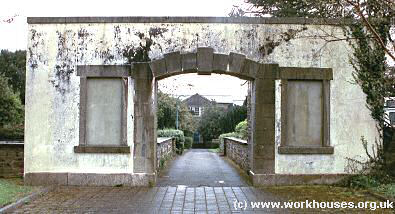
Falmouth remains of entrance archway from the west, 2001.
© Peter Higginbotham.
The main accommodation range was an E-shaped layout, three storeys high.
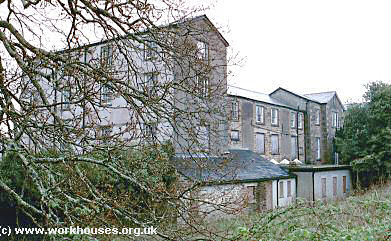
Falmouth workhouse main block from the north-west, 2001.
© Peter Higginbotham.
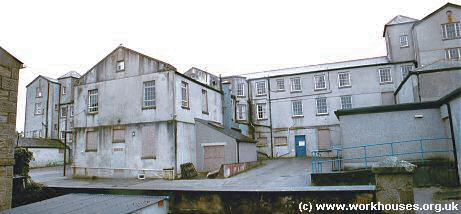
Falmouth workhouse main block from the north-east, 2001.
© Peter Higginbotham.
The first master of the new workhouse was Mr James, previously in charge of the Falmouth Town workhouse. After 1852, the latter was used to house child paupers. In 1861, the inmates number more than 100. The building subsequently became a British School. It was then purchased by the Falmouth Schools Board in 1898 and became Smithwick School, which was used for various educational purposes until its demolition in the 1970s.
In 1871, a small block containing infectious wards was erected at the north-east corner of the new workhouse site at a cost of £500.
In 1894, the British Medical Journal set up a "commission" to investigate conditions in provincial workhouses and their infirmaries. Following a visit to Falmouth, the commission's report found that just one nurse, untrained, was employed for the whole infirmary, with paupers as her assistants. She also acted as the workhouse's midwife. There was no night nurse. If a doctor was needed at night, he was fetched by a messenger on foot — a distance of nearly two miles into Falmouth. Although sick inmates were generally well cared for, the infirmary buildings were too old and inconvenient for their purpose: the wards were small and lacked basic amenities such as baths and hot water. The construction of a new and properly staffed infirmary was recommended to serve the needs of the sick poor of the town and its neighbourhood. Further details are available in the full report.
In 1897, perhaps in response to the BMJ's report, a new infirmary block costing £2,148, was erected at the east of the workhouse main block.
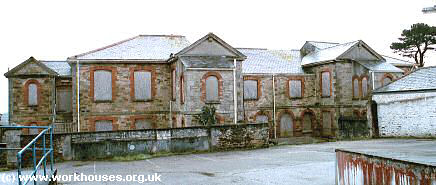
Falmouth infirmary block from the west, 2001.
© Peter Higginbotham.
The later layout of site is shown on the 1933 map below, by which time the establishment had become Falmouth Public Assistance Institution:
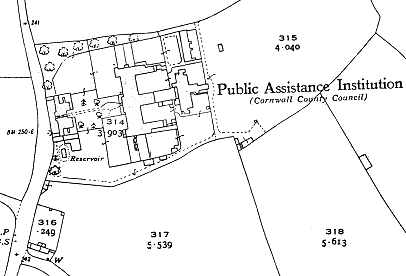
Falmouth workhouse site, 1933.
The institution was later called Budock House, then following the inception of the National Health Service in 1948, it became Budock Hospital. In 2001, the former workhouse buildings were lying disused but have now been demolished and the site is being redeveloped as a housing estate.
Children's Home
By the 1920s, the union was operating a children's home at 11 Clare Terrace, Falmouth. The building still exists, now in private residential use.
Staff
Inmates
Records
Note: many repositories impose a closure period of up to 100 years for records identifying individuals. Before travelling a long distance, always check that the records you want to consult will be available.
- Cornwall Archives, Kresen Kernow, Little Vauxhall, Redruth TR15 1AS. Relatively few records survive — holdings include Guardians' minute books (1839-1930); etc.
Bibliography
- Higginbotham, Peter The Workhouse Encyclopedia (2014, The History Press)
Links
Acknowledgment
- Thanks to Ruth Hodges (descendant of Edward and Mary Tregaskis) for information on Penryn.
Unless otherwise indicated, this page () is copyright Peter Higginbotham. Contents may not be reproduced without permission.



